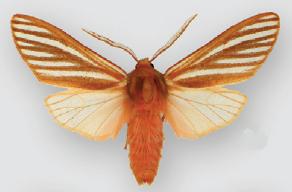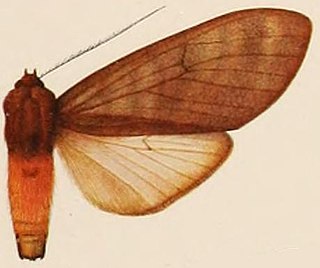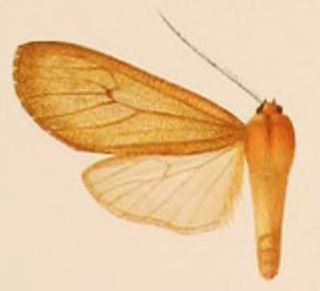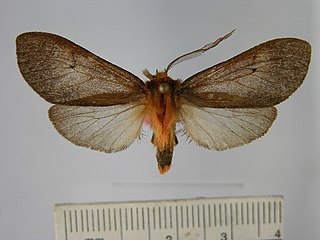
Christopher George Latore Wallace, better known by his stage names the Notorious B.I.G., Biggie Smalls, or simply Biggie, was an American rapper and songwriter. Rooted in the New York rap scene and gangsta rap traditions, he is considered one of the greatest rappers of all time. The Notorious B.I.G. became known for his distinctive laidback lyrical delivery, offsetting the lyrics' often grim content and his own intimidating appearance. His music was often semi-autobiographical, telling of hardship and criminality, but also of debauchery and celebration.

The Phaegopterina are a subtribe of tiger moths in the tribe Arctiini, which is part of the family Erebidae. The subtribe was described by William Forsell Kirby in 1892.

Amastus is a genus of moths in the family Erebidae. The genus was erected by Francis Walker in 1855.
Hemihyalea is a monotypic moth genus in the family Erebidae erected by George Hampson in 1901. Its only species, Hemihyalea cornea, was first described by Gottlieb August Wilhelm Herrich-Schäffer in 1853.

Phragmatobia is a genus of moths in the subfamily Arctiinae described by Stephens in 1828. Many tiger-moth species of small and medium size were described within this genus. However, only a few are related to the type species.

Pseudohemihyalea is a genus of moths in the family Erebidae described by Régo Barros in 1956. While the caterpillars of most species of Pseudohemihyalea feed on broad-leaved trees, the P. ambigua group has larvae that feed on conifers. Their forewing coloration has accordingly evolved to light-and-dark lengthwise striping, giving better camouflage among the slim needles of the host plants. In this, they seem to be convergent to certain geometer moths, such as Caripeta piniata or Sabulodes niveostriata.

In telecommunications, 5G is the fifth generation technology standard for broadband cellular networks, which cellular phone companies began deploying worldwide in 2019, and is the planned successor to the 4G networks which provide connectivity to most current cellphones. 5G networks are predicted to have more than 1.7 billion subscribers worldwide by 2025, according to the GSM Association. Like its predecessors, 5G networks are cellular networks, in which the service area is divided into small geographical areas called cells. All 5G wireless devices in a cell are connected to the Internet and telephone network by radio waves through a local antenna in the cell. The main advantage of the new networks is that they will have greater bandwidth, giving higher download speeds, eventually up to 10 gigabits per second (Gbit/s). Due to the increased bandwidth, it is expected the networks will not exclusively serve cellphones like existing cellular networks, but also be used as general internet service providers for laptops and desktop computers, competing with existing ISPs such as cable internet, and also will make possible new applications in internet of things (IoT) and machine to machine areas. 4G cellphones are not able to use the new networks, which require 5G enabled wireless devices.

Amastus umber is a moth of the family Erebidae first described by Walter Rothschild in 1909. It is found in Venezuela.

Amastus rufocinnamomea is a moth of the family Erebidae first described by Walter Rothschild in 1909. It is found in Peru.

Amastus muscosa is a moth of the subfamily Arctiinae first described by Walter Rothschild in 1909. It is found in Peru.
Amastus collaris is a moth of the family Erebidae. It was described by Gottlieb August Wilhelm Herrich-Schäffer in 1853. It is found in Venezuela, Peru, Colombia and Ecuador.
Amastus rufothorax is a moth of the family Erebidae. It was described by Hervé de Toulgoët in 1999. It is found in Peru.
Amastus bicolor is a moth of the family Erebidae. It was described by Peter Maassen in 1890. It is found in Ecuador and Peru.
Amastus cellularis is a moth of the family Erebidae. It was described by Walter Rothschild in 1922. It is found in Peru.

Amastus rubicundus is a moth of the family Erebidae first described by Hervé de Toulgoët in 1981. It is found in Peru.
Amastus mossi is a moth of the family Erebidae. It was described by Walter Rothschild in 1922. It is found in Peru and Ecuador.
Amastus walkeri is a moth of the family Erebidae. It was described by Walter Rothschild in 1922. It is found in Peru.
Opharus lehmanni is a moth of the family Erebidae. It was described by Walter Rothschild in 1910. It is found in Colombia.
Amastus modesta is a moth in the family Erebidae. It was described by Peter Maassen in 1890. It is found in Bolivia.
Pseudohemihyalea melas is a moth in the family Erebidae. It was described by Paul Dognin in 1902. It is found in Colombia.








